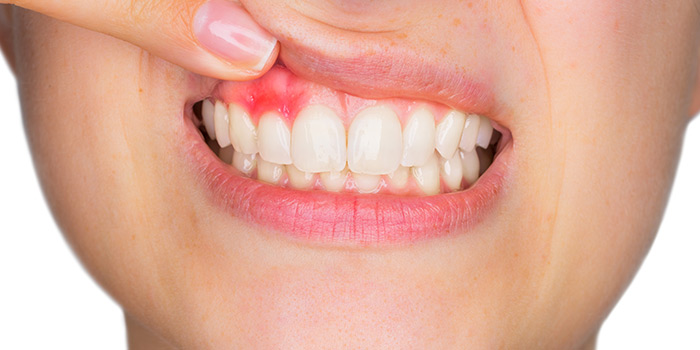August 27, 2019
Periodontitis or gum disease causes inflammation of the soft tissue (gum) and bone supporting the teeth. It is caused by certain types of bacteria infecting and producing acid against the gums. This elicits an immune response from the body which causes inflammation and in advanced cases causes resorption of the bone surrounding the teeth.
Gum disease can initially appear visually as red rings around the gumline, where the teeth and gums meet. If left untreated, gum disease can lead to advanced periodontitis. Below we will go through the five stages of gum disease and the symptoms of each.

Stage 1: Healthy Teeth & Gums
The gums are well looked after, they appear firm and pinkish (depending on skin tone). The patient brushes their teeth twice daily for two minutes and flosses daily using dental floss or interdental brushes.
The teeth are also well supported by the bone all the way up to the crown of the tooth. Healthy gums have very shallow and easy to clean pockets (like a collar) around the tooth.
Stage 2: Gingivitis
The gums now have a red ring or margin where the tooth and gum meet and appear puffy / swollen. Plaque / calculus has accumulated under the gumline causing infection, which may be tender and bleed.
Bleeding may occur during or after brushing and flossing. Gingivitis can happen quickly with poor oral hygiene routines. The good news is, gingivitis is reversable after the removal of bacteria.
Stage 3: Early Periodontitis
When gingivitis is left untreated it will continue to worsen, developing into early periodontitis.
At this stage, bacteria infect the bone supporting the tooth and cause it to resorb slightly. The gums appear more irritated, making the pocket deeper and harder to clean.
The bone loss which has occurred is non-reversable; however, the gum inflammation is, and with good oral hygiene and regular dental visits, this processed can be halted.
If you are experiencing tender or bleeding gums, you should visit your dentist as soon as possible.
Stage 4: Moderate Periodontitis
In moderate periodontitis, the bone level drops further, and the teeth can become loose.
Once a patient has reached this stage, it can become difficult for them properly clean their own teeth. This is because the gum pockets have deepened, or the gums have shrunk away, leaving gaps between the teeth and gumline. Food can become trapped in these pockets which a toothbrush may not be able to clean. This food trapping can also cause cavities in-between teeth.
At this stage, a patient will require 3-monthly deep cleans.
Stage 5: Advanced Periodontitis
Once advanced periodontitis or gum disease has developed, bone levels have dropped to a stage where the teeth are no longer well supported.
The teeth may be very loose and are often able to be depressed down into the socket, as well as side to side. These teeth have a very poor prognosis as they can pose a choking hazard or interfere with the bite.
Gum Disease Treatment at Coastal Dental Care
If you are experiencing any of the symptoms outlined above it is highly advisable you visit your dentist for a comprehensive examination. Treating gum disease early can effectively revert or halt symptoms.
Contact one of our friendly practices or book an appointment online today.

